People often compare Cashmere and silk, as many have a hard time choosing between these two. The reason for that is silk and Cashmere are both luxury fabrics. People wear both of these to special occasions. Hence there is a confusion about which one to wear at what occasion. So today, we tell you the differences between the both and how is one better than the other.
Cashmere is the finest wool that herders manually procure from the Changra Goats in Changthangi. Ladakhi Cashmere is finer than human hair with a diameter of 12 to 16 microns. Beautifully crafted in the Valley of Kashmir, the finest Cashmere is procured from the region of Changhthanghi Ladakh. The finest wool is termed Ladakhi Cashmere due to several reasons. On the other hand, the fabric of silk is a different type of entity that silkworms produce. There is a significant difference in both the fabrics from their procurement to the crafting and the result. The expensiveness is defined in the high-quality procurement and crafting of both fabrics. Therefore, it is evident from the fact that Cashmere is more luxurious than silk due to various reasons. The reasons lie in the differences between Cashmere wool and Silk.
What is Silk?
Silk is a natural protein fibre that comes from the cocoons of silkworm larvae. Common masses have highly valued for its luxurious feel, sheen, and smooth texture for centuries. Here's everything you might want to know about silk:
Production Process of Silk
Silkworms are the primary source of silk. The silk production process begins when silkworm eggs hatch into larvae. The larvae are fed mulberry leaves and undergo several molting stages, during which they shed their skin. After the final molt, the silkworm spins a cocoon around itself using a fluid secreted from special salivary glands.
Silk Types
Silk can be classified into two categories. Mulberry Silk is the most common type of silk. Silkworms that are fed exclusively on mulberry leaves produce it. On the other hand, Wild Silk is produced by silkworms that feed on plants other than mulberry, resulting in a coarser texture and less uniform color.
Silk Production
The harvested cocoons are boiled or steamed to soften the sericin (a protein glue) that holds the cocoon together. Makers of this luxury fabric unravel the softened cocoon to produce long silk threads. They then twist these threads together to form silk yarn. Artisans can weave this silk yarn into fabric by these artisans later on.
Properties and Characteristics
- Softness: Silk is popular for its luxurious and smooth texture. For this reason, manufacturers use silk in luxury outfits like expensive sarees, lavish shawls, or dresses. Silk is often chosen as a gift for those who love luxury fashion.
- Luster: Silk has a natural sheen that reflects light, giving it a shiny appearance. Hence, silk garments have an extravagant look and people wear them on special occasions.
- Lightweight: Despite its strength, silk is very light and breathable. Hence, silk dresses become the perfect choice for summer.
- Strong: Silk fibres are surprisingly strong and have good tensile strength. Because of its ability to bend and stretch without breaking, manufacturers use silk in parachutes, medical sutures, and other life-saving devices.
- Hypoallergenic: Silk is generally hypoallergenic and can be a good option for people with sensitive skin. Often women attach a cotton lining to the outfits made from silk.
Uses of Silk
- Clothing: Silk is used to make various types of clothing, including dresses, shirts, blouses, ties, and lingerie. Sill gives quite a luxurious look and women prefer wearing silk over other fabrics.
- Accessories: Manufacturers have used Silk to make luxury scarves, handkerchiefs, and other accessories. Silk scarves have been immensely famous in the 18th-19th centuries. These became an integral part of fashion. Both men and women wore it and hence used as a symbol of elegance and refinement.
- Bedding: Silk sheets, pillowcases, and duvet covers are famous for their comfort and smoothness. These give a lavish look to the entire bedroom. Often a newly wedded couple adorn their bedrooms with silk bedding and upholstery.
- Home Textiles: Makers use Silk in curtains, upholstery, and other home décor items. Silk gives a lavish touch to rooms and completely revives them.
- Industrial and Medical Applications: Silk's unique properties have led to exploration in various fields, including sutures, surgical mesh, and parachutes.
- Bridal Wear: Silk's luxurious appearance and comfortable feel make it a popular choice for bridal attire. Brides often choose silk wedding dresses for their elegant drape and timeless beauty. Silk veils add a delicate touch to bridal ensembles, contributing to an ethereal look.
- Art and Craft: Silk's versatility has inspired artists and crafters to use it as a medium for their creations. Silk can be used as a canvas for painting or printing, resulting in vibrant and detailed artwork. Patrons highly value silk embroidery for its smooth texture and ability to hold intricate stitches.
Cultural and Historical Significance
Silk has a long history, originating in ancient China around 4,000 years ago. The Silk Road was a network of trade routes that connected the East to the West, facilitating the exchange of goods, ideas, and cultures. Historians have associated silk with luxury, wealth, and prestige in various cultures throughout history.
Care
Silk is delicate and requires special care. Specialists often recommend to hand wash silk garments using mild detergent and cool water. Dry cleaning can also be suitable for some silk items.
Silk continues to be popular for its unique properties and historical significance. It remains a symbol of luxury and elegance in modern times
Cashmere vs Silk
Silk is said to be inferior to cashmere in terms of insulation and warmth. Due to its fine fibres and inherent crimp, cashmere wool, which comes from the velvety undercoat of cashmere goats, has remarkable thermal properties. Because of these characteristics, cashmere clothing offers exceptional warmth and insulation, making it ideal for cold climates. While silk is famous for its plush texture and gloss, it does not provide the same level of thermal insulation as cashmere. As a result, patrons favour cashmere over silk for protection and comfort in cold climates because of its remarkable warmth.
Finest Cashmere is rare while Silk is abundant
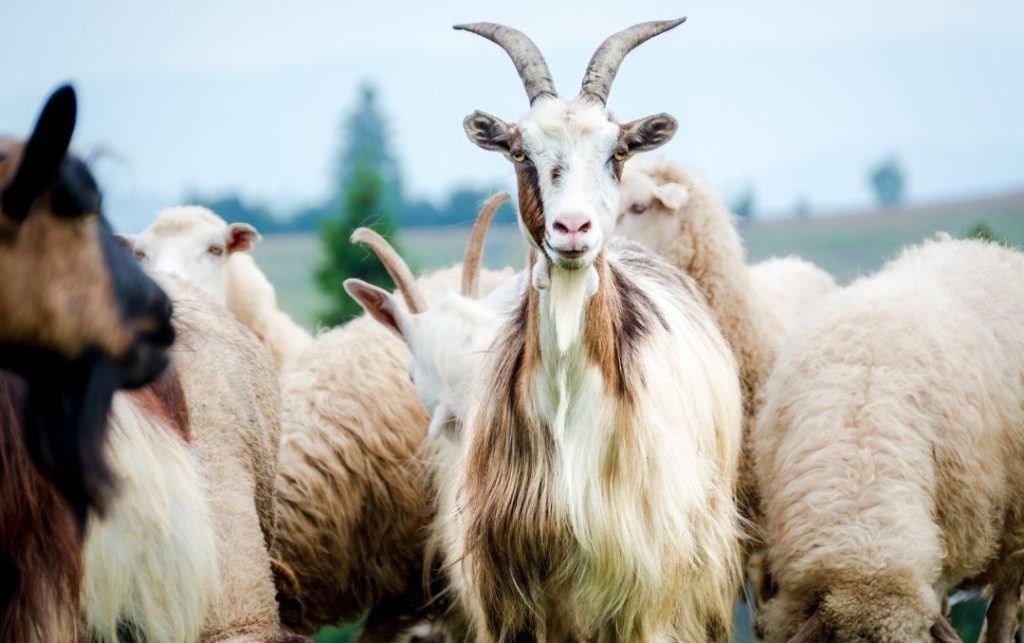
There are diverse breeds of cashmere-producing goats. Each breed has a specific percentage of production in the total production. The several breeds viz; Australian Cashmere Goat, Liaoning, Inner Mongolia, Xinjiang, Hexi, Zhonghwei, Tibetan Plateau, Luliang breeds, Changthangi, etc. Therefore, all the breeds produce the Cashmere wool that produces the warmth. The exclusive breed of goats called Changra Goats is a rare species of goats. The production is very low due to this rare species found only in Changhthanghi.
In addition, the Goats produce fine Cashmere wool once every year. Therefore, a meagre production of just around 80 to 170 gms of Ladakhi Cashmere occurs per year. Therefore, considered the rarest. Also, other breeds of it produce several times more as there are almost 400 million Cashmere eliciting Goats all over the world. Consequently, the production caters to the manufacture of different styles like Pashmina Shawls, Cashmere Scarves, and Cashmere Wraps. Silk is abundant in the country of India as the production is quite high. In adiition, silk production is not confined to only one region of India. And, the abundance of silkworms is up to a high level, therefore, the production is not affected.
Fine Cashmere is the softest while silk is coarser
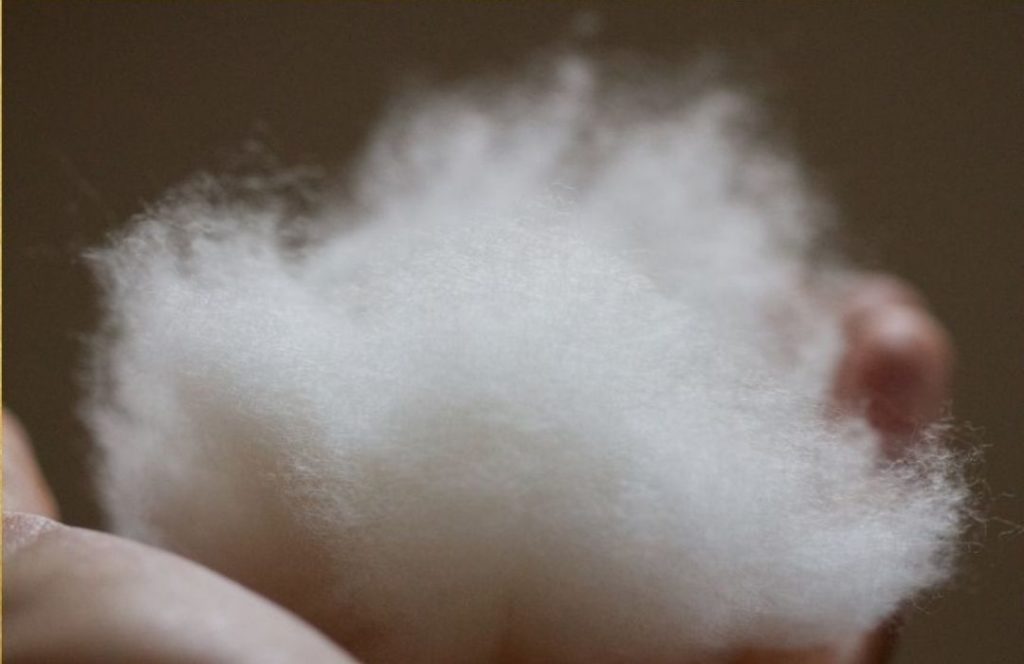
Cashmere is the finest wool that Changra Goats produce, and is the softest. Herdsmen manually procure it from the underbelly of the Cashmere goat. It is 12 to 16 microns in diameter.
On the contrary, Silk is obtained from the cocoon of the moth of the silkworm. It is courser and is very delicate. Artisans make it thicker by spinning it several times to make the strength to make fabric.
Fine Cashmere is Crafted by hand while Silk is merely crafted by machines
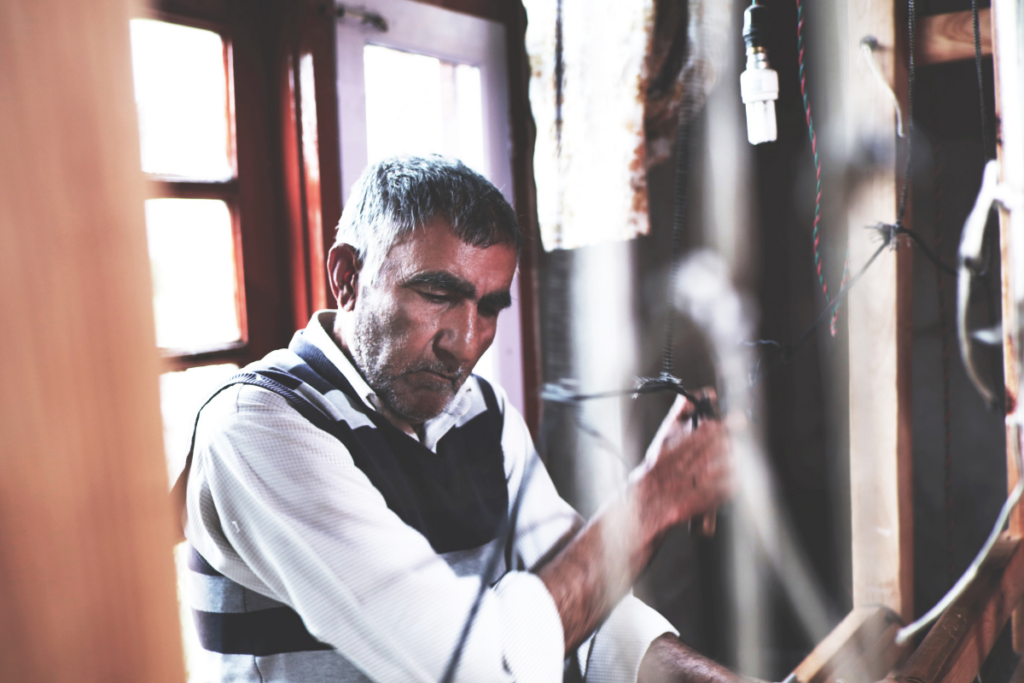
Pashmina is the Art of handcrafting the finest Ladakhi Cashmere. From the procurement to the handcrafting of the finest Cashmere, the art witnesses the overall arrival of luxurious craft. Artisans manually process all the steps involved in crafting a Pashmina. Thus, preserving the high quality. On the other hand, the thread made from spinning can be done by traditional spinning wheel or wooden charkha. Power looms in the factory, can do that same in less time. Also, another material blending is done by adding poly or cotton or anything so that the thread is stronger to survive.
Fine Cashmere is only Crafted in Kashmir while Silk is crafted in all the states of India
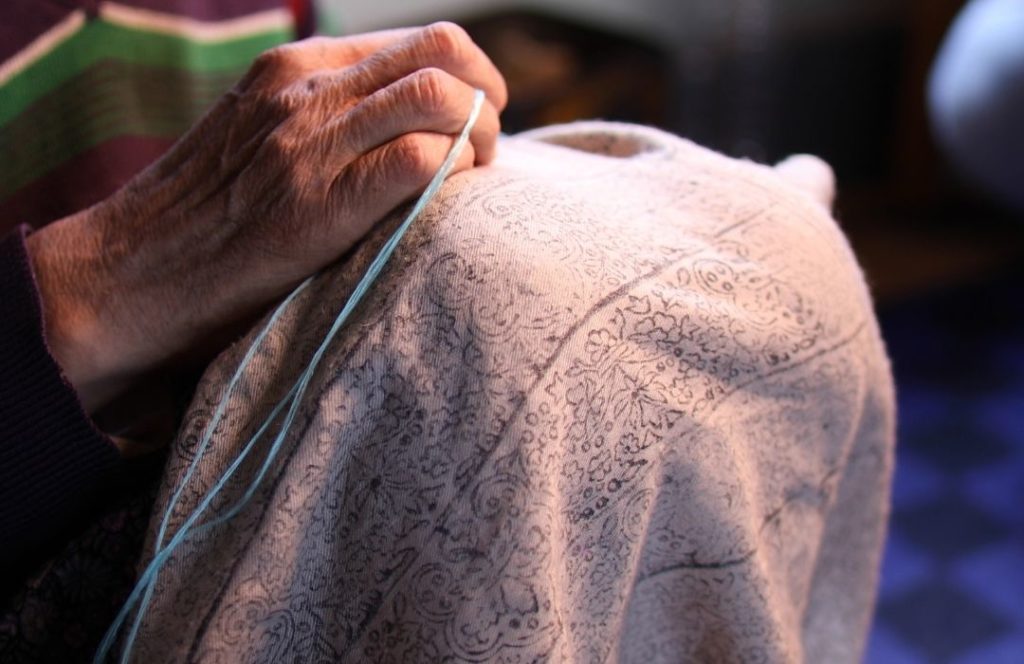
Pashmina is predominately the traditional craft of Kashmir Valley. It is the crafting of the finest Cashmere procured from Changhthanghi, Ladakh. It is the journey of Cashmere wool from Ladakh to Kashmir. Also, Pashmina is the hallmark of Kashmir Valley. Silk is produced in several states of India like Banaras, Tamil Nadu, Bengal, etc, and is crafted in abundance, but Cashmere is comparatively confined. Therefore, Silk is less expensive.
Is Cashmere and Silk Warm?
There are many blends of cashmere and silk available in the market. These blends can offer the best of both worlds, with the warmth of cashmere and the luxurious feel and temperature-regulating properties of silk. Cashmere-silk blends can provide a balance between warmth and breathability, making them suitable for a wider range of temperatures.
While both cashmere and silk have their own unique qualities, cashmere is warmer and more suitable for cold weather due to its insulation properties. Silk, on the other hand, is more known for its breathability and comfort. Cashmere-silk blends can offer a combination of warmth and luxury, making them versatile options for various weather conditions.
Superiority of Cashmere
The Changhthanghi plateau extends into the region of Ladakh. It is a high-altitude region in Ladakh. The herders around the Ladakhi Changhthanghi are of the Changpa tribe. The tribe herds the rarest breed of Goats called Changra.
At high altitudes, the temperature lowers to the minimum. The winters are the harshest in this region of Changhthanghi. Therefore, the Changra Goats naturally cover their bodies with thick wool to combat the harsh winters. All along the winters, the thick wool reserves the heat beneath their bodies giving them the warmth of nature. On the seasonal change in climate, the goats naturally shed off the wool with the help of coarse rocks and trees. To overcome the heat of summer, they eventually shed off the thick wool mostly from their bellies, neck region, and behind the ears. In addition, the herders also comb out the wool manually. The soft wool is Cashmere wool.
Luxurious Crafting of Fine wool makes it one-of-a-kind
After combing out the Cashmere wool, artisans clean it off the excess dust and filled in the packets to transfer to the valley of Kashmir. Later they sort the Cashmere wool which undergoes several procedures in the valley itself. The cleaning, drying, and soaking make the Cashmere wool vividly clean. Afterward, the Cashmere wool is translated to the finest fibers by the process of spinning. The yarn of fineness is transferred to the handlooms in the valley to weave the yarn into several styles of accessories. The whole process of spinning and weaving the finest Cashmere is the Art of Pashmina. Moving along the art of Pashmina, several other processes like dyeing, printing, interweaving, and embroidering the Cashmere cater to the exclusive collection of Cashmere. The art of Pashmina cherishes every inch of the finest Cashmere to bring luxury to the world.
The reason why the finest Cashmere is expensive
The main reason of finest Cashmere is expensive is it's high quality and traditional value. The beauty of the finest cashmere comes from its origin which depicts the nature of the luxurious wool. The heritage of Kashmir has handicrafts that are highly luxurious. Pashmina Craft is a handicraft among the other premium handicrafts. Cashmere is the finest wool that comes from a rare species of Goats called Changra Goats. To craft the luxury of Cashmere, Pashmina Art of Kashmir reflects the grace of hand skill of artisans on it. Therefore, it is the crafting of the finest Cashmere procured from Changra Goats who dwell at the feet of Changhthanghi, Ladakh. The craft of Pashmina is an indigenous craft belonging to the luxury of fashion.
The craft of Pashmina reigns in the beauty of Kashmir since the 13th century. It is a gift from the saint of Persia who discovered the rare species of Goats in Chanthanghi. He entailed the luxury of Pashmina Craft in Kashmir. Afterward, the royals adorned the Craft of Pashmina. It is an art that prevailed through centuries proving its legacy all over the world including European aristocrats and Armenian merchants. For centuries, Europeans were the largest owners of Pashmina accessories. French empress Josephine owned more than 400 Kani Pashmina Shawls from Kashmir to supplicate her beauty with luxury. In India, the Mughals had a great affinity with Pashmina Craft. Emperor Akbar had such a fondness for the Pashmina shawl that he gave it an admirable nickname, "parm-narm" meaning “supremely soft”.
Patterns found in Cashmere
Cashmere has captured the hearts of fashion enthusiasts around the world for its softness, warmth, and unparalleled elegance. Apart from this, Cashmere is versatile, where it beats silk. Beyond its sumptuous texture and warmth, Cashmere is also renowned for its diverse array of patterns that silk doesn't have. From traditional designs to contemporary creations, the patterns found in Cashmere tell stories of culture, art, and craftsmanship.
Solid Pashmina
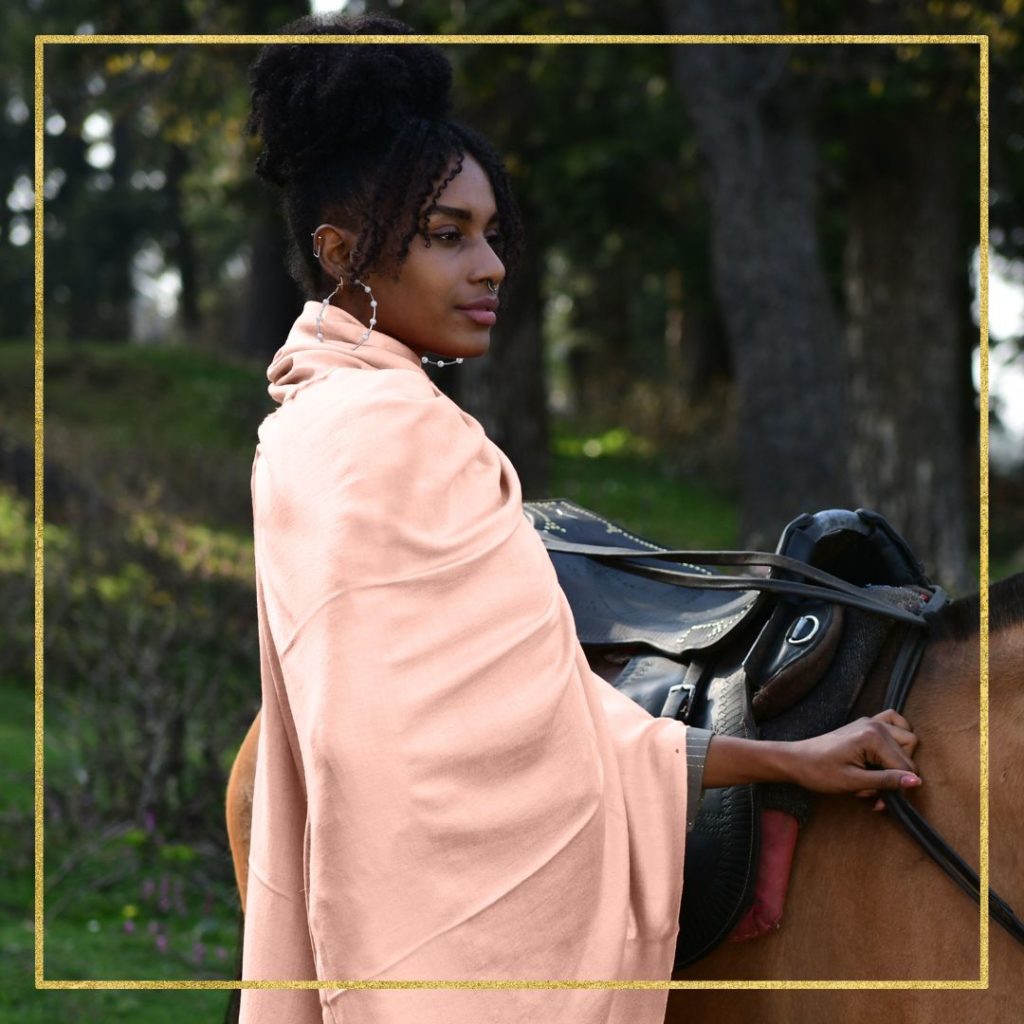
Solid Cashmere scarves exude timeless elegance with their monochromatic beauty. These scarves boast a single, uniform color that allows the exquisite texture of the Cashmere to take center stage. From deep jewel tones to delicate pastels, solid Cashmere scarves are versatile accessories that can effortlessly elevate any outfit, making them a must-have in any wardrobe.
Embroidered Cashmere
Embroidered Cashmere scarves are a testament to the intricate craftsmanship that goes into creating these pieces of wearable art. Skilled artisans meticulously stitch intricate patterns, such as floral motifs, paisley designs, and delicate filigree, onto the fabric. The embroidery is often enhanced with wool, silk, or metallic threads, adding a touch of luxury to the final creation. Various embroideries done on Cashmere are:
Sozni Embroidery
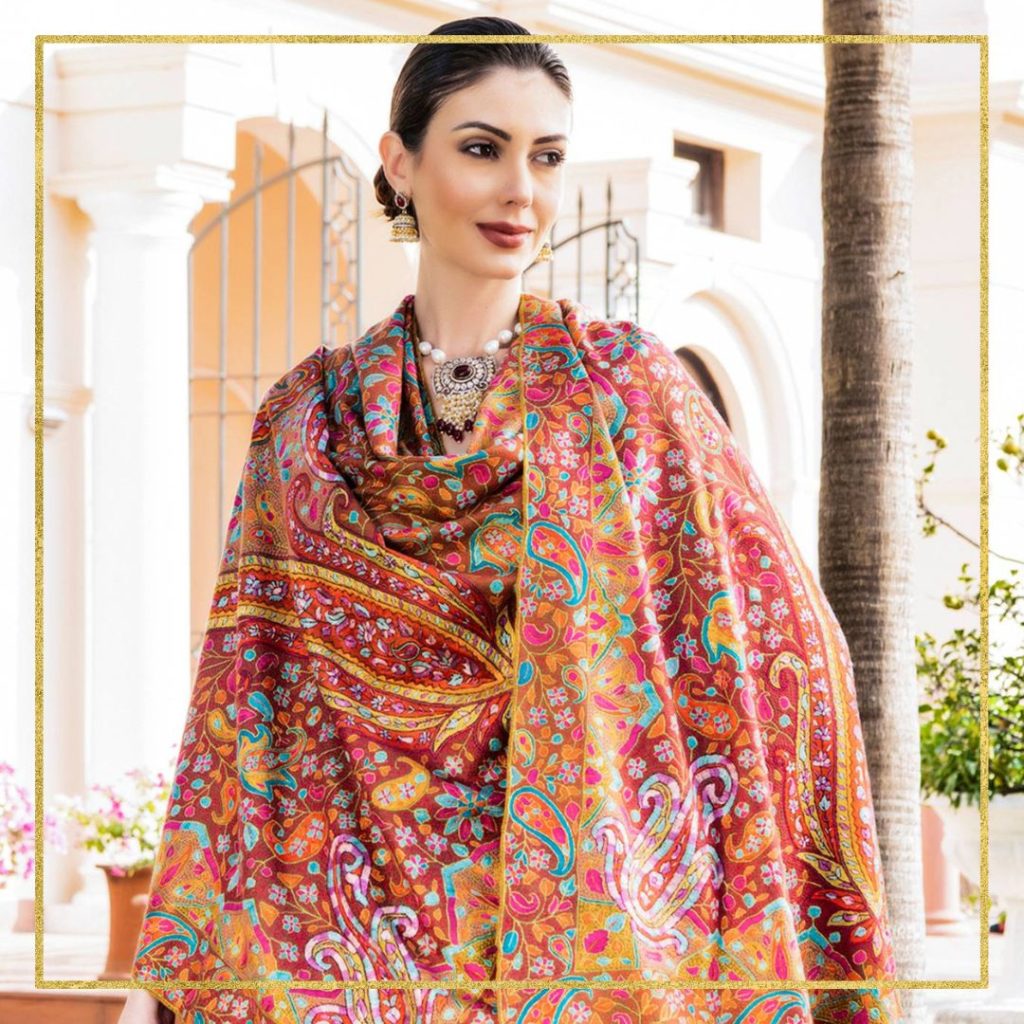
Sozni embroidery is a traditional technique hailing from the picturesque valleys of Kashmir in India. It involves delicate and intricate needlework, often done by hand. Skilled artisans meticulously create elaborate patterns using fine threads, resulting in breathtaking designs that reflect the rich cultural heritage of the region. The charm of Sozni embroidery lies in its intricate motifs, which can include floral patterns, paisleys, and fine lines that intertwine to create a mesmerizing effect.
Tilla Embroidery
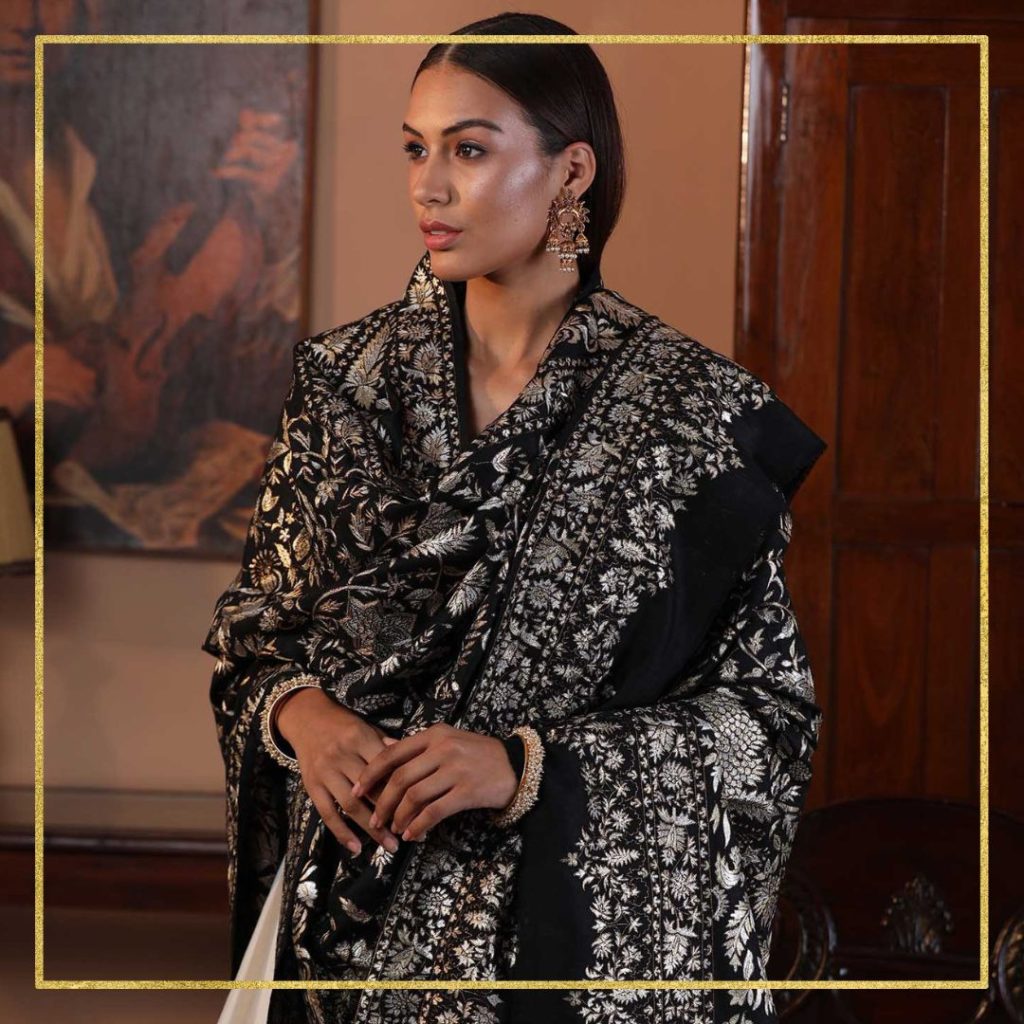
Tilla embroidery, also known as Tilla Dozi involves the use of metallic threads, dipped in real gold or silver, to create lavish and opulent designs on Cashmere fabric. Originating from the royal courts of Mughal India, Tilla embroidery adds a touch of grandeur and luxury to Cashmere shawls and scarves.
Tilla embroidery was commonly used in Mughal courts. Kings and nobles would get the courts embellished with Tilla Dozi. Hence real gold and real silver threads would be used to embroider curtains, sofa covers, beddings, and even floorings. Mughals immensely admired the Tilla embroidery, and it was only they, during this time, who could afford the same. Later, to make Tilla affordable for the common masses, real gold and silver weren't used. Instead, metallic threads were dipped in gold and silver and used for embroidering.
Papier Mache Embroidery
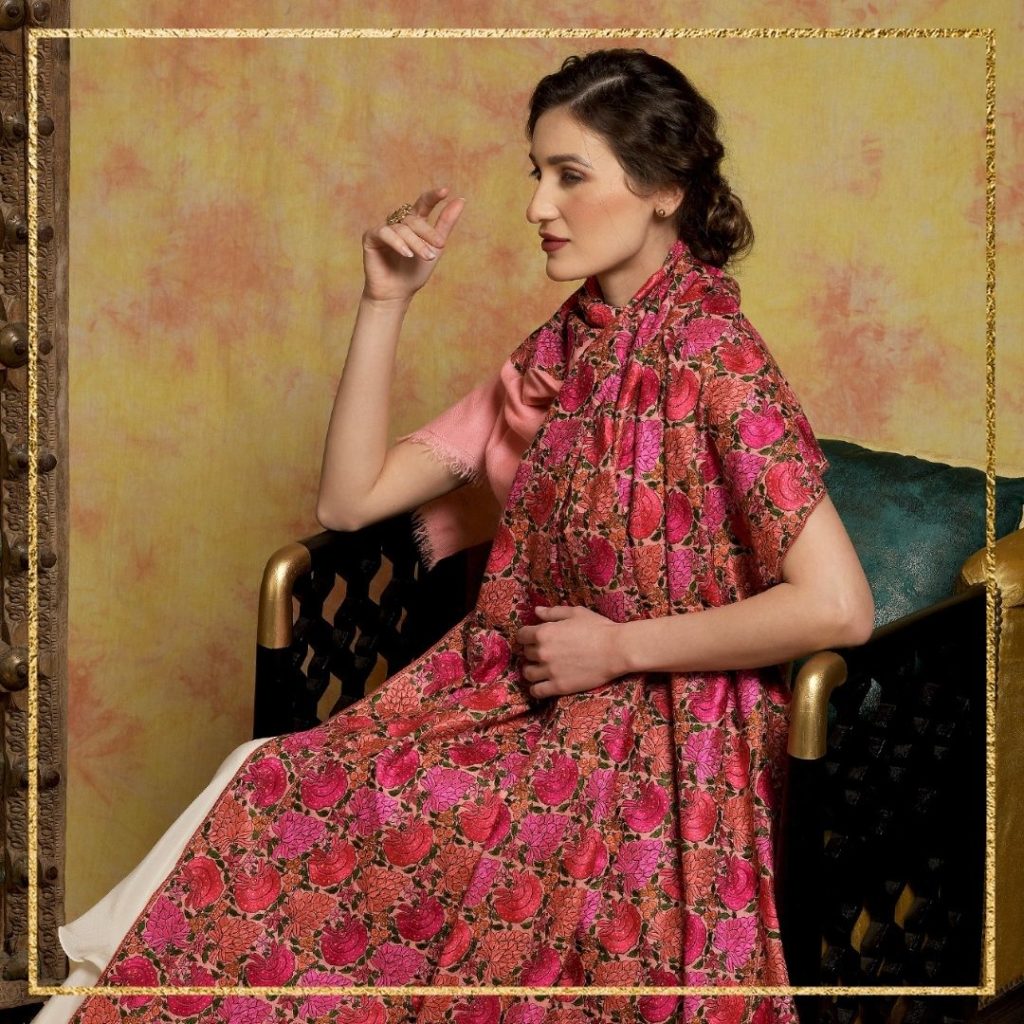
Papier Mache embroidery is a unique technique that combines traditional Papier Mache artistry with delicate needlework. Artisans create thick colourful patterns, often depicting floral or nature-inspired motifs, which are then intricately stitched onto the fabric. This technique adds a three-dimensional element to the embroidery, creating a tactile and visually captivating effect.
Paper mache Cashmere shawls are often used to drape over a Kashmiri bride as she steps out of her maternal home towards the next journey.
Kani Cashmere
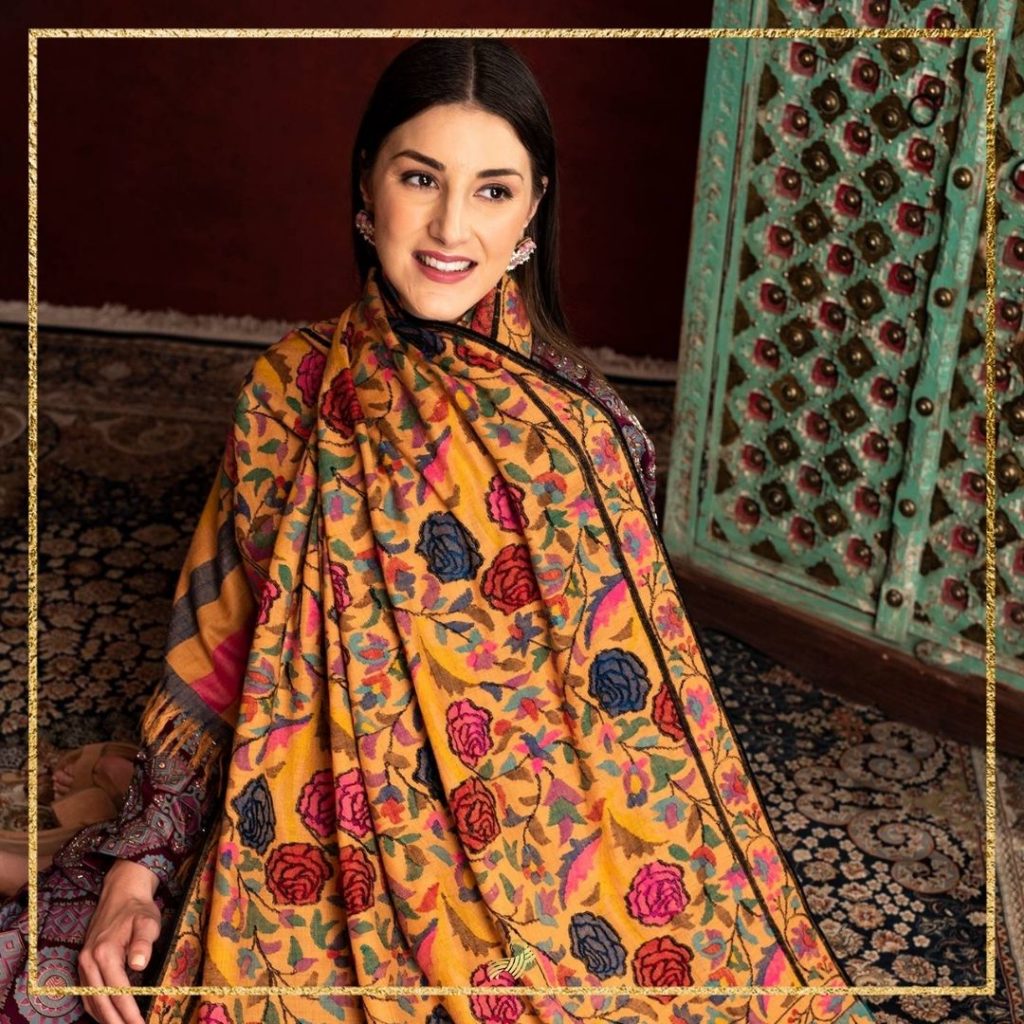
Kani Cashmere is a true masterpiece that showcases the mastery of weaving techniques. Wooden sticks called "kanis" are used to control the colored threads during the weaving process, resulting in intricate patterns and designs. These scarves often depict traditional motifs like florals, paisleys, and geometric shapes. Kani Cashmere scarves are not only a testament to artistic skill but also a representation of cultural heritage.
Kani Cashmere scarves are the most expensive and adored pieces of accessories. Since it takes 4 to 5 years to complete just one shawl, the shawls are often worn at weddings or similar special occasions.
Also read: WHY IS THE KANI SHAWL EXPENSIVE?
Shibori Cashmere
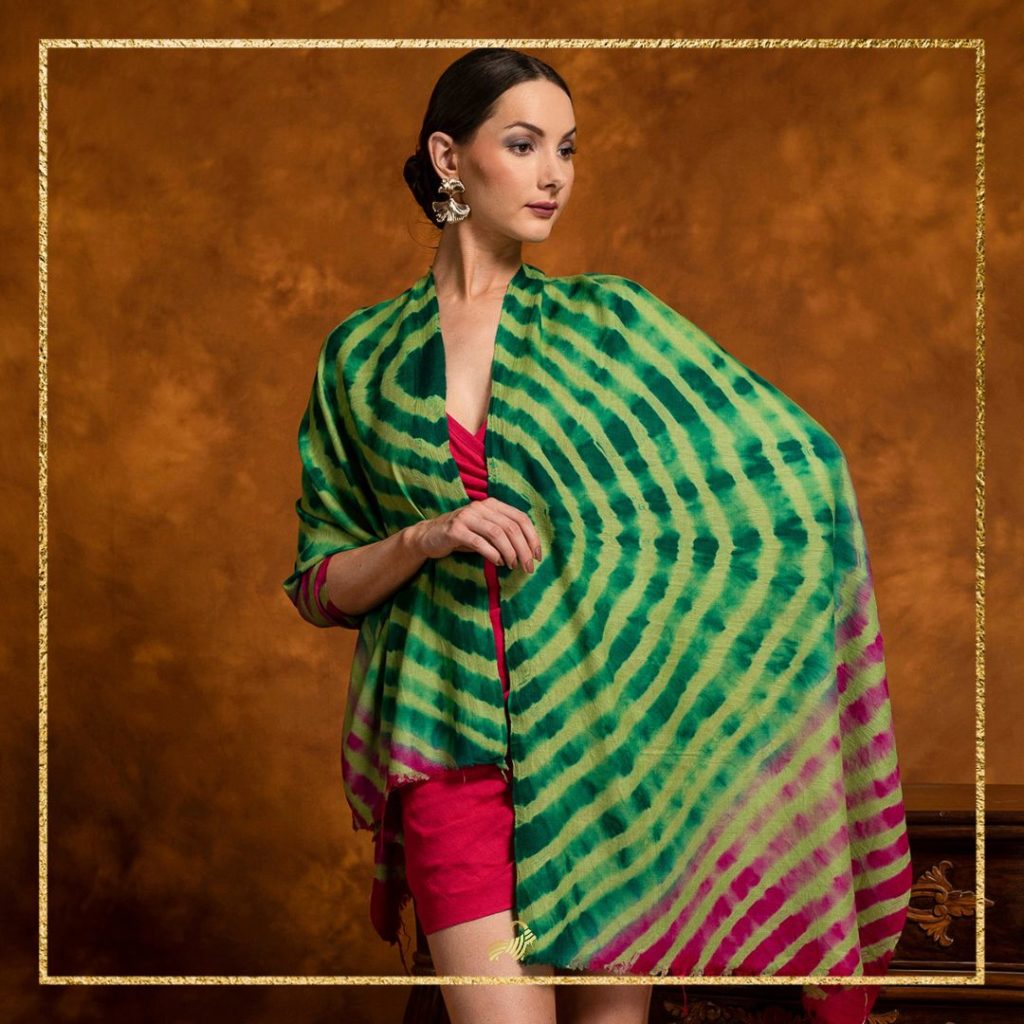
Shibori Cashmere scarves are a canvas for artistic expression. These scarves can feature a wide range of designs, from intricate traditional motifs to contemporary abstract art, adding a burst of creativity to your ensemble.
Women often wear scarves to casual gatherings. The reason for this is that it carries many shades at once. These go with the free and high-spirited nature of a casual outing where fun and frolic prevail.
Ombre Beauty
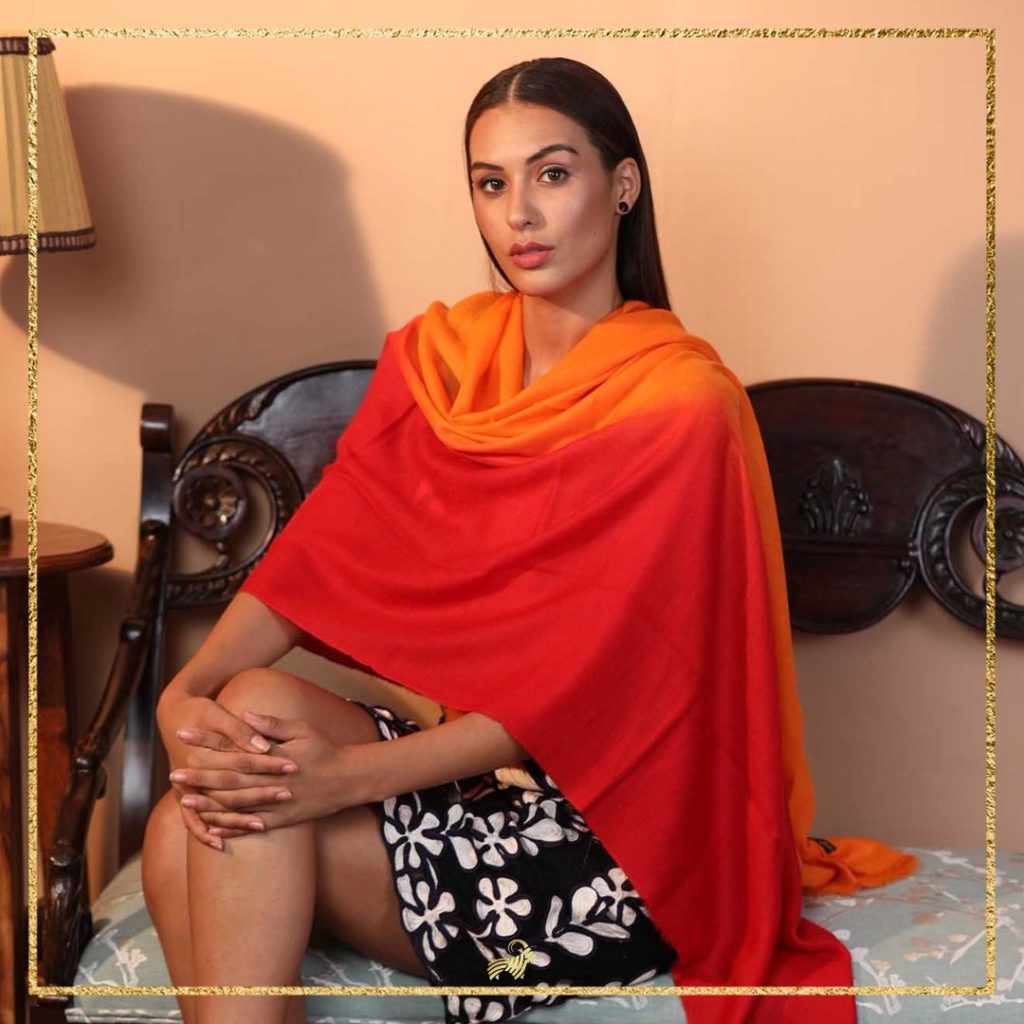
Ombre Cashmere scarves play with the subtle art of color transition. Gradually shifting from one shade to another, these scarves create a visually stunning effect that adds depth and dimension to your outfit. Ombre scarves are a sophisticated way to incorporate multiple colours into your ensemble seamlessly. These scarves can be worn to offices as well as to casual dates with friends and family. Muted, pastels and similar shades are chosen for formal occasions. Brighter and colorful scarves are preferred for casual outings.
Also read: IS CASHMERE A GOOD GIFT?
Conclusion
Cashmere scarves and shawls are a testament to the rich tapestry of human creativity, culture, and craftsmanship. From the traditional elegance of paisley to the contemporary allure of abstract designs, each pattern tells a story and adds a layer of sophistication to these exquisite accessories. Whether you opt for the timeless simplicity of solid Cashmere or the intricate beauty of embroidered and Kani patterns, one thing is certain: Cashmere scarves are not just clothing; they are works of art that celebrate the fusion of tradition and innovation.
This definitely doesn't mean that silk is any lesser. Silk scarves are luxurious as well as lightweight. their sheen wonderfully reflects one's personal style and demeanor. Silk scarves were the most popular in the 18th and 19th centuries. And nothing has changed when it comes to the lavish grace these pieces exude.
Also read: WHAT SCARVES ARE IN STYLE FOR 2023?